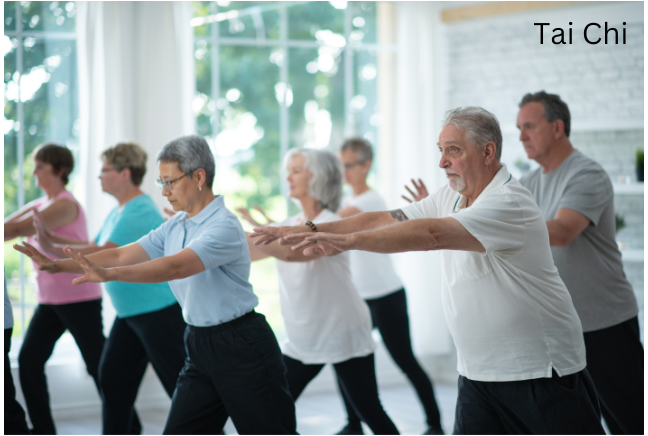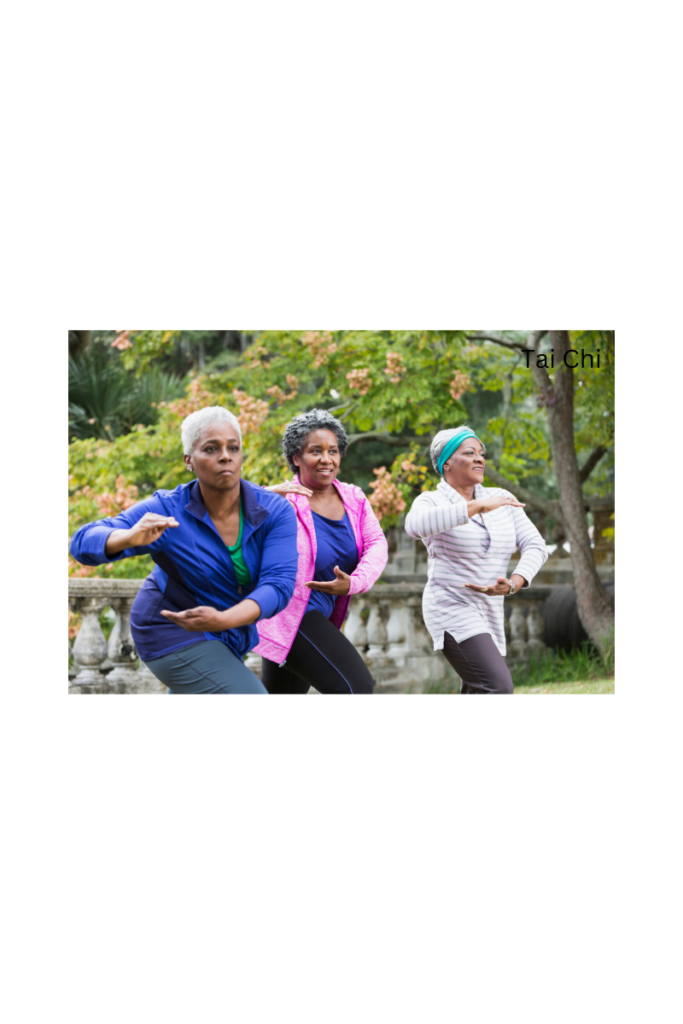
Tai Chi, with its roots buried deep in ancient China, has evolved from a form of martial arts into a cherished practice for wellness. Picture flowing movements paired with deep, mindful breathing—sounds like a peaceful way to exercise, doesn’t it? This is what makes Tai Chi stand out, especially for seniors.
Unlike other high-impact exercises that might leave you feeling worn out, Tai Chi is like a gentle river, offering balance, flexibility, and peace. It’s all about moving smoothly, almost like a slow dance, which is particularly beneficial as we age and our balance needs a little extra support.
This gentle exercise is not just about moving, but also about breathing and focusing, helping us keep stress at bay and boosting our mental well-being. And it’s pretty heart-friendly too. Even though it won’t get you huffing and puffing like a jog would, it supports cardiovascular health by improving blood circulation.
Overall, Tai Chi offers a great way to keep active while being kind to the body, making it an awesome choice for those wanting to maintain physical health without the crutches of intense workouts. Ready to discover how Tai Chi can sprinkle some extra goodness into your life? Let’s begin the journey.
Understanding the Basics of Tai Chi
Tai Chi is all about harmony and balance. Imagine a form of exercise where you’re not just burning calories but nurturing your mind and spirit, too. It’s like a moving meditation, blending gentle movements with mindfulness. This dual focus makes Tai Chi uniquely beneficial for seniors.
There are a few different styles of Tai Chi, each with its own flavor. The Yang style, with its steady, flowing movements, is favored by many older adults for its gentle approach. It’s less intense and more about big, sweeping motions that are easier on the joints.
Adapting Tai Chi to fit personal needs is crucial. It’s perfectly okay to modify moves so they feel right for you. Whether standing or sitting, balance and comfort come first! This adaptability means you’re working within your own comfort zone, reducing the risk of pushing too hard while still reaping the benefits.
It’s important to keep in mind that Tai Chi should be a journey, not a race. It’s not about how quickly you can move or how high you can kick—it’s about finding flow and enjoying the experience. Embrace the slowness; it’s good for the body and soul.
Starting Your Tai Chi Journey
Embarking on your Tai Chi journey is like setting sail on calm waters—it’s exciting yet soothing. One of the best ways to get started is by finding a qualified instructor. They’re like the captains of this smooth sailing trip, guiding you with expertise and patience to ensure you’re getting the movements just right.
While you might wonder if you can learn Tai Chi on your own, having an instructor can make a big difference, especially in the beginning. They can tap into your unique needs, offer personalized advice, and adjust techniques tailored to you. But if classes aren’t an option, don’t worry! There are plenty of online resources and videos available. Some even offer modifications specifically designed for seniors.
When you’re just starting out, consistency is your best friend. Aim to practice a few times a week. It’s not about the intensity but about building a routine that feels comfortable for you. Tai Chi’s not meant to be hurried, so take it slow and relish each move. Let’s say you commit to practicing three times a week—start with short, enjoyable sessions and gradually extend them as you get more confident.
Remember, this journey isn’t about keeping up with anyone else. It’s about discovering a personal rhythm that aligns with your body and lifestyle. Each chapter of Tai Chi is a step towards balance and mindfulness, bringing benefits that ripple through everyday life.
Maximizing Benefits: Crafting Your Tai Chi Routine
Once you’ve got the basics down, it’s time to create a routine that fits seamlessly into your life. Imagine Tai Chi as a gentle habit, one you look forward to because it enhances your day without overwhelming it.
For many seniors, doing Tai Chi three to five times a week works wonders. Even a brief session of 10-20 minutes daily can bring about noticeable improvements in balance and calmness. The key is finding a rhythm that suits your energy levels and commitments.
Consistency is the magic word here. The more regularly you practice, the more your body and mind will benefit. This doesn’t mean you need to step into a rigid schedule, though—flexibility is just as important. Some days a quick session might be perfect, while other days you might enjoy a longer, more immersive practice.
Think of Tai Chi as part of your lifestyle, rather than an item on your to-do list. Integrate it with activities you already enjoy. For instance, if you love gardening or morning walks, a Tai Chi session can be a lovely way to start or end your time outside.
Remember, the aim isn’t to master everything immediately but to cultivate a sustainable, enjoyable practice. Over time, you’ll likely find that Tai Chi becomes a natural, comforting part of your daily or weekly routine.
Essential Tips for Success in Tai Chi Practice
Starting with the right gear can make your Tai Chi practice more enjoyable. Opt for comfortable, loose-fitting clothes that allow you to move freely. Imagine your favorite cozy outfit—something that lets you stretch without restriction.
Creating a safe practice space is equally important. Aim for a spot that’s clear of clutter, with enough room to perform your movements without bumping into things. A calm, quiet environment can really enhance your focus.
Listening to your body is crucial. It’s easy to get carried away, but remember, Tai Chi is all about gentle progress. If a movement feels tough, take a step back and modify it to suit your limits. The goal is to feel good, not overworked.
Staying hydrated is often underrated. Even if Tai Chi doesn’t seem like a sweaty workout, keeping a water bottle nearby is a smart move. Sip regularly to stay refreshed—that way your body stays in harmony with your movements.
Lastly, bring mindfulness into your practice. As you perform each movement, focus on how it feels, the way your body shifts, and how it connects with your breathing. This awareness is like a mini-vacation for the mind, enhancing the calming effects of Tai Chi.
Finally: Embracing the Tai Chi Lifestyle
Tai Chi isn’t just an exercise; it’s a gateway to a more balanced and peaceful lifestyle. As you become familiar with its rhythmic movements and soothing practices, you might notice these effects seeping into your everyday life.
Imagine approaching daily tasks with the same calm and mindfulness you practice in Tai Chi. It’s like creating a ripple effect, where the wellness gained from Tai Chi encourages a healthier approach to everything—from stress management to physical well-being.
One of the most beautiful aspects of Tai Chi is its ongoing journey. There’s always something new to explore or a technique to refine, which keeps the practice engaging and rewarding. Even if your pace is leisurely, every practice session contributes to stronger balance, improved flexibility, and reduced stress.
Encourage yourself to share this practice with friends or loved ones. Starting a Tai Chi routine as part of a group can build community and offer mutual motivation. Consider joining a local class or community center where you can connect with others on a similar journey.

Ultimately, Tai Chi offers a lifestyle of grace and peace, urging us to blend factors of physical health and emotional tranquility into a harmonious daily rhythm. No matter how you choose to embrace it, Tai Chi is about enjoying every step along the way.
Please note that the information provided in Senior Citizen Fitness Blog articles cannot replace individual advice from health professionals. Please consult your physician before starting a new fitness program.


